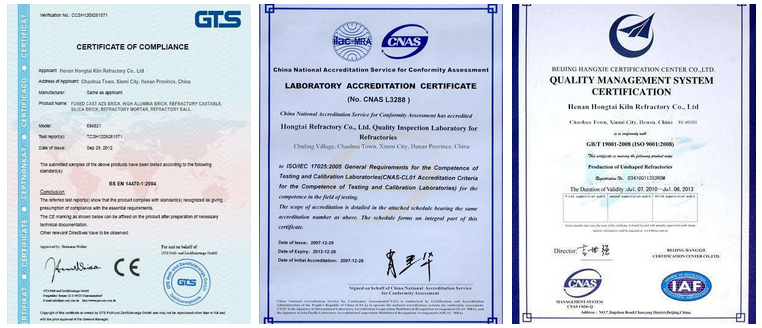Henan Hongtai Kiln Refractory Co.,Ltd. |
|
Verified Suppliers
|
|
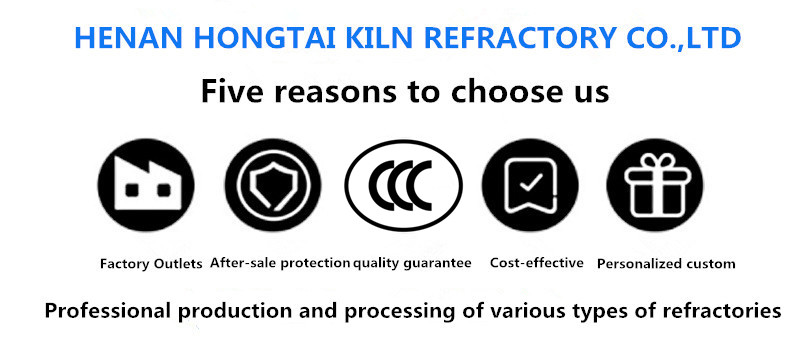



Introduction of the performance and production process of refractory magnesia carbon brick
Magnesia carbon brick is a refractory material made of high-melting-point alkaline magnesium oxide (melting point 2800 ° C) and high melting point carbon material which is difficult to be infiltrated by slag, adding various non-oxide additives and combining carbonaceous binder. Magnesia carbon bricks are mainly used in converters, AC arc furnaces, linings of DC arc furnaces, slag lines of ladle, and the like.
Magnesia carbon brick Usually, the melting loss of magnesia carbon brick is carried out by reacting magnesia with slag on the working surface. The melting loss rate depends on the nature of the magnesia itself and on the size of the magnesia particles. Larger particles have higher corrosion resistance, but they are more likely to escape from the working face of the magnesia carbon brick to the slag. Once this happens, the rate of damage of the magnesia carbon brick will be accelerated.
Magnesia carbon brick The absolute expansion of large particles of magnesia is larger than that of small particles. In addition, the expansion coefficient of magnesia is much larger than that of graphite. Therefore, in the MgO-C brick, the large particle/graphite interface of magnesia is produced at the interface of small particles/graphite of magnesia. The stress is large, and the crack generated is also large, which indicates that the critical grain size of the magnesia in the MgO-C brick is small, which has the effect of relieving thermal stress.
Magnesia carbon brick From the aspect of product performance, the critical particle size becomes smaller, the open pores of the product decrease, and the pore diameter becomes smaller, which is beneficial to the improvement of the oxidation resistance of the product; at the same time, the internal friction between the materials is increased, the molding is difficult, and the density is lowered. Therefore, in the production of MgO-C bricks, it is very difficult to generalize the critical particle size of magnesia-silica. It is often necessary to determine the critical particle size of the magnesia based on the specific conditions of use of the MgO-C brick. In general, MgO-C bricks used in places with large temperature gradients and intense thermal shocks need to choose a smaller critical particle size; while those requiring high corrosion resistance, the critical grain size required is required.
1. Magnesia fine powder Magnesia carbon brick
Magnesia carbon brick In order to maintain the overall uniformity of the thermal expansion of the particles and the matrix portion of the MgO-C brick, the matrix portion needs to be mixed with a certain amount of fine powder of magnesia, and also the structure maintains a certain integrity after partial oxidation of the matrix.
However, if the fine powder of magnesia is too fine, the reduction rate of MgO will be accelerated, thereby accelerating the damage of the MgO-C brick. Magnesia sand less than 0.01mm is easy to react with graphite, so it is best not to mix such too fine magnesia when producing MgO-C bricks. In order to obtain MgO-C bricks with excellent performance, the ratio of magnesia to graphite of less than 0.074 mm in MgO-C bricks should be less than 0.5, and if it exceeds 1, the porosity of the matrix portion is sharply increased.
2, the amount of graphite added Magnesia carbon brick
Magnesia carbon brick The amount of graphite added should be considered in combination with different bricks and different parts of the brick. In general, if the amount of graphite added is less than 10%, it is difficult to form a continuous carbon network in the product, and the carbon may not be effectively exhibited; the amount of graphite added is more than 20%, the molding is difficult during production, cracks are easily generated, and the product is easily oxidized. Therefore, the amount of graphite added is generally between 10% and 20%. According to different parts, different amounts of graphite are selected. The melting loss of MgO-C bricks is governed by the oxidation of graphite ink and the dissolution of MgO into the slag. Increasing the graphite can reduce the erosion rate of slag, but it increases the oxidation of gas phase and liquid phase. Damaged.
3, mixing Magnesia carbon brick
Magnesia carbon brick The graphite is light in density and tends to float on top of the mix during mixing, making it incompletely in contact with other components in the furnish. High speed mixers or planetary mixers are generally used. When producing MgO-C bricks, if the feeding order is not paid attention to during the mixing, the plasticity and formability of the slurry will be affected, thereby affecting the yield and performance of the product.
Magnesia carbon brick The correct order of addition is: magnesia (coarse, medium) → binder → graphite → magnesia powder and additives mixed powder. The mixing time varies slightly depending on the mixing equipment. If the mixing time is too long, the graphite and the fine powder around the magnesia are easily peeled off, and the mud is dried due to the large amount of solvent in the binder; if it is too short, the mixture is uneven and the plasticity is poor, which is not favorable for molding. .
4, molding Magnesia carbon brick
Magnesia carbon brick Molding is an important way to increase the packing density and densify the structure of the product. Therefore, high-pressure molding is required, and the pressing is strictly carried out according to the operating procedure of light weight, heavy weight and multiple pressurization. When producing MgO-C bricks, the density of bricks is commonly used. Controlling the forming process, the higher the tonnage of the general press, the higher the density of the brick, and the less binder required for the mixture (otherwise, due to the shortening of the distance between the particles and the thinning of the liquid film, the bonding agent is partially localized, resulting in several The structure of the product is not uniform, which affects the performance of the product and also causes the elastic aftereffect to cause the brick to crack.
5, hardening treatment Magnesia carbon brick
Magnesia carbon brick The phenolic resin-bonded MgO-C brick can be heat treated at a temperature of 200 to 250 ° C. The resin can be directly (thermosetting resin) or indirectly (thermoplastic resin) hardened to give the product a high strength, and the general processing time is 24 ~32h, of which 50~60°C needs to be kept warm due to resin softening; 100~110°C needs to be kept warm due to large amount of solvent evaporation; 200~250°C needs heat preservation due to condensation hardening of the bonding agent.
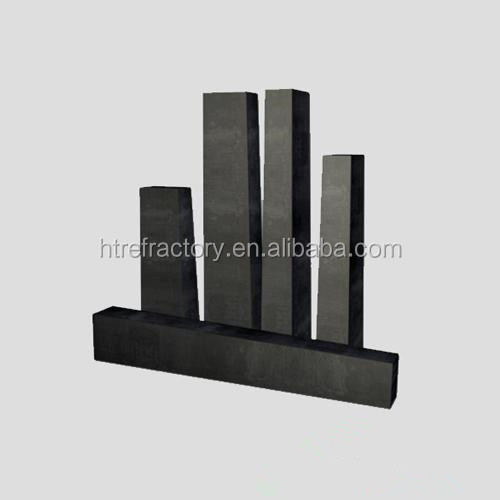
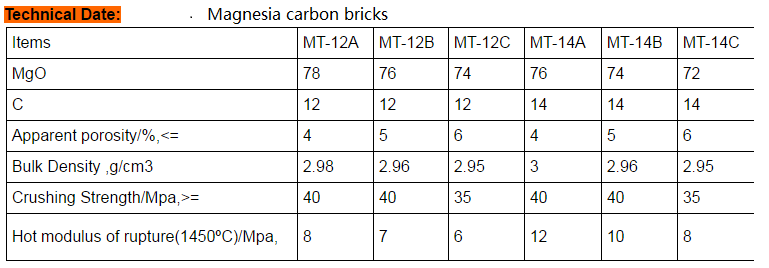
Selection of magnesia carbon bricks for various parts of the converter
To understand the application of magnesia carbon bricks in various parts of the converter, first of all, it is necessary to understand the working environment of various parts of the converter. The following are the reasons why the parts are susceptible to erosion damage.
1.Furnace mouth Magnesia carbon bricks
Magnesia carbon bricks When charging, blowing, tapping, pouring slag, the temperature changes greatly, the slag is eroded, the dust is exhausted, the material is washed, the steel is cleaned, and the slag is mechanically impacted.
2. Furnace cap Magnesia carbon bricks
Magnesia carbon bricks When sampling and tapping, it is eroded by slag, and the temperature changes greatly. When the furnace is empty, the carbon in the brick is easily oxidized and is eroded and worn by the exhaust gas and dust.
3. Furnace Magnesia carbon bricks
Magnesia carbon bricks Loading side: Due to the impact and erosion of scrap steel and molten iron, the temperature changes greatly.
Magnesia carbon bricks The tapping side is affected by the erosion and wear of the slag and molten steel, and is subjected to thermal shock and erosion by the slag and molten steel during tapping.
Magnesia carbon bricks Trunnion area: There is less slag hanging in the furnace lining. When the furnace is empty, the carbon in the brick is oxidized, and the furnace is subjected to abnormal force when tilting.
Slag line: slag erosion. Magnesia carbon bricks
Bottom: It is strongly washed and worn by molten steel.
4. Top-bottom composite blowing converter bottom gas supply brick Magnesia carbon bricks
Magnesia carbon bricks Chemically attacked and violently washed by molten steel and slag, sudden temperature changes and oxidation.
5. Steel tap Magnesia carbon bricks
Magnesia carbon bricks It is washed by molten steel, and the slag is eroded and the temperature changes drastically.
Application of magnesia carbon brick on converter
Magnesia carbon bricks According to the above analysis, the temperature of the furnace mouth and the furnace cap changes drastically, and the slag corrosion is severe. The magnesia carbon brick with good thermal shock resistance and strong slag resistance should be selected. On both sides of the trunnion, except for the damage caused by blowing, the surface is covered with no protective slag layer, which is difficult to repair. The carbon in the brick is easily oxidized, and high-quality magnesia carbon brick with good slag resistance and good oxidation resistance should be built. The slag line is in contact with the slag for a long time, and the slag is severely damaged. It is necessary to build a magnesia carbon brick with excellent slag resistance. The splashing effect of slag and molten steel on the charging side is easy to cause chemical attack, abrasion, erosion and direct impact and erosion when loading scrap steel and molten iron. It should be used with strong slag resistance, high temperature strength and thermal shock resistance. Good magnesium carbon brick. The bottom of the hearth is lighter than other parts, and ordinary magnesia carbon bricks can be used. When the top-bottom composite blowing technology is adopted, especially when the gas such as CO2 and O2 is blown at the bottom, the damage is more serious. High-grade magnesia carbon bricks with good oxidation resistance and thermal shock resistance, high temperature strength and high slag resistance should be selected. According to the characteristics of the furnace body damage, different grades of magnesia carbon bricks are used to form a comprehensive furnace lining.


1)Raw material to factory→checkout→burdening→stirring→mixing→taking
out the raw material,
2)Crushing→Mixing→Shaping→Drying→Firing→Inspection→Packaging and
Shipment.
2.Quality Assurance
1)Going out the furnace→checkout→packing→qualified product→putting
in storage→sale,
2)The process from raw to product are strictly tested by equipment.
1.Inspection and Control of incoming raw materials: according to
the chemical content,raw materials are classified into different
levels to ensure quality of brick first.
2.Inspection and control of the process: during the
production,every brick will be weighed twice strictly to reduce the
error of weight .
3.Quality audit by quality management: inspection of product
standardization of quality of each product by process control and
experimentation, taking corrective measures timely whenever
deviations are noted.
4.Before delivery, the inspectors will inspect the size,appearance,
physical and chemical properties of brick again in factory.

Packaging of refractory bricks
1.on wooden pallets with plastic cover: wooden pallet size :930*930
or 1000*1000mm,
2.Load weight of each pallet: 1.5-2.0 tons,
3.230*114*65mm:512PCS/Pallet, 230*114*75mm:448PCS/Pallet.
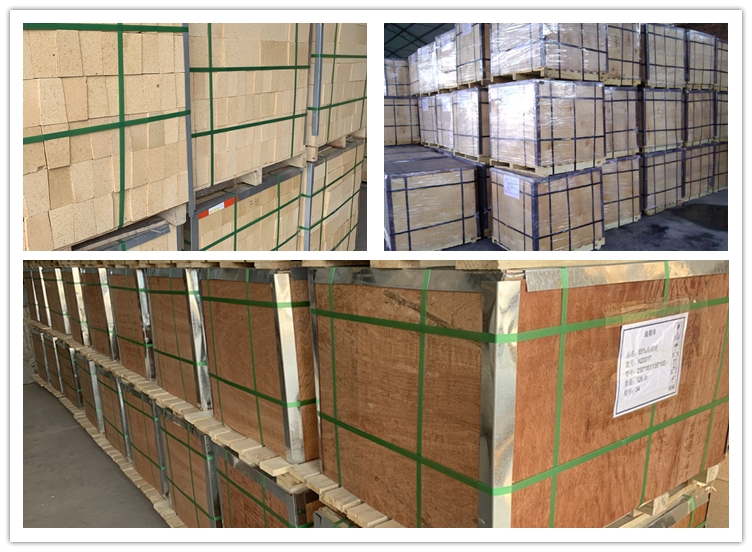
Shipping of refractory bricks
1.Our packaging is as per customer’s request
2.Normal goods delivered by sea transport
3.Sample shipping by express
4.We will shipping and delivery goods timely, quanlity and quantity
guaranteed, and also in accordance with the contract and customer's
requirment completely.


1. Strong professional:
Our company has thirty years producing experience in refractory
products. Our manager will supervise on a various refractorys
production materials, process control, quality supervision and
package delivery, and ensure the products are 100% qualified.
2.Annual supply:
Our company has passed ISO9001 quality management system
certification certification. And the annual supply of shaped and
unshaped refractory product is 28, 800-35, 000 tons.
3. Export experiences:
Now we have gained a global sales network reaching Taiwan, Russia,
Vietnam, Pakistan, Bulgaria, French, India, Congo, Angola, South
Africa, and so on.
4. Production equipment:
Production and testing equipments are new, complete and automated
or semi- automated. Such modern facilities and equipments have
provided the fine technical guarantee for the production and
testing.
5. Testing equipment:
Our company's testing equipments as follows:
High Temperature RUL Tester
Bulk Density Tester
The Pressure Tester
Refractoriness Tester
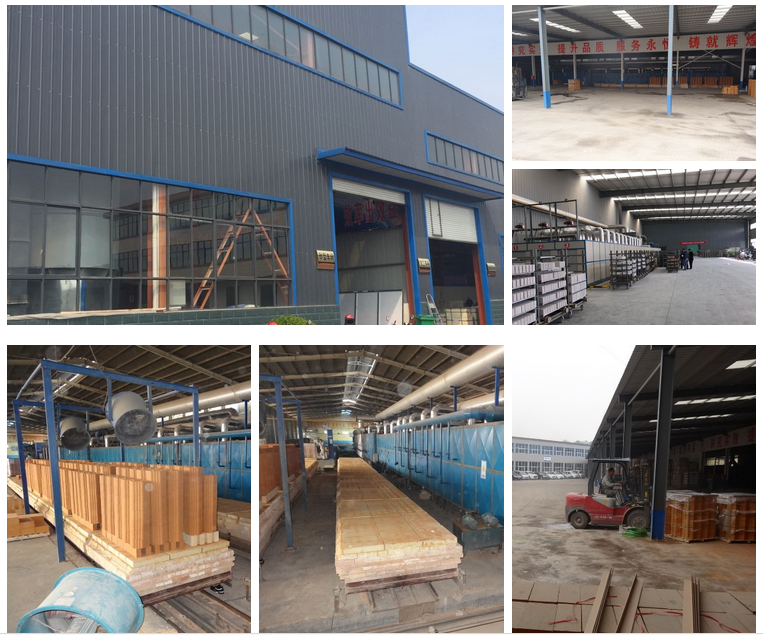
Certificates
